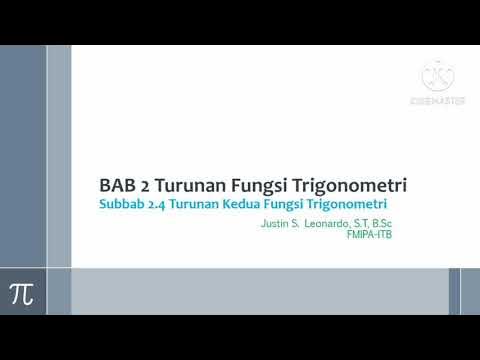Higher order derivatives | Chapter 10, Essence of calculus
Summary
TLDRThis educational video script delves into the concept of higher order derivatives, particularly focusing on second derivatives. It explains how the second derivative represents the rate of change of the slope, indicated by the curvature of a graph. Positive values suggest an increasing slope, while negative values indicate a decreasing one. The script also touches upon the third derivative, humorously termed 'jerk,' which measures changes in acceleration. The discussion is set to segue into the application of higher order derivatives in approximating functions, specifically through Taylor series.
Takeaways
- 📕 The script introduces the concept of higher order derivatives, specifically focusing on the second derivative as a precursor to discussing Taylor series.
- 💵 The first derivative of a function represents the slope of the graph at any given point, indicating the rate of change.
- 📗 The second derivative is the derivative of the first derivative, indicating how the slope of the graph is changing.
- 📐 A positive second derivative indicates the graph is curving upwards, meaning the slope is increasing, while a negative second derivative indicates the graph is curving downwards, meaning the slope is decreasing.
- 💲 The notation for the second derivative is often written as \( \frac{d^2f}{dx^2} \), which represents the limit of the ratio of the change in the function's change to the change in \( x \) as \( x \) approaches zero.
- 📊 The script uses the analogy of movement along a line to explain the second derivative as acceleration, where the first derivative represents velocity.
- 💵 The third derivative, humorously referred to as 'jerk', indicates how the acceleration is changing, showing whether the rate of speed increase or decrease is itself increasing or decreasing.
- 📖 Higher order derivatives are essential for approximating functions, which is crucial for understanding the upcoming topic of Taylor series.
- 💲 The script provides a visual example to help understand the concept of the second derivative, comparing graphs with different slopes and curvatures.
- 💵 The second derivative's sign (positive or negative) corresponds to the sensation of speeding up or slowing down in motion, respectively.
- 📗 The concept of 'jerk' is introduced as the third derivative, which is significant for understanding changes in acceleration.
Q & A
What is the main focus of the next chapter after discussing Taylor series?
-The main focus of the next chapter is higher order derivatives, particularly the second derivative, and its application in the context of graphs and motion.
What is the significance of higher order derivatives in the context of the script?
-Higher order derivatives are significant as they provide insights into how the slope of a function is changing, which is crucial for understanding concepts like acceleration and jerk in physics.
How is the second derivative related to the curvature of a graph?
-The second derivative is related to the curvature of a graph by indicating whether the graph is curving upwards (positive second derivative) or downwards (negative second derivative).
What does a positive second derivative at a certain point on a graph indicate?
-A positive second derivative at a certain point on a graph indicates that the slope is increasing at that point, suggesting the graph is curving upwards.
What is the physical interpretation of the second derivative when considering motion?
-The second derivative has a physical interpretation as acceleration when considering motion, as it tells you the rate at which the velocity is changing.
What is the term used for the third derivative in the context of motion?
-The third derivative in the context of motion is humorously referred to as 'jerk', which indicates how the acceleration is changing.
How does the second derivative help in approximating functions?
-The second derivative helps in approximating functions by providing information about the concavity and rate of change of the function, which is useful in series expansion techniques like Taylor series.
What is the standard notation for the second derivative?
-The standard notation for the second derivative is written as \( \frac{d^2f}{dx^2} \), which represents the derivative of the derivative with respect to \( x \).
What does the term 'ddf' in the script refer to?
-The term 'ddf' refers to the change in the change of the function, which is proportional to the square of the small change in \( x \) (dx^2), and it is used to define the second derivative.
How does the script suggest visualizing the process of calculating the second derivative?
-The script suggests visualizing the process by taking two small steps to the right with a size of dx, observing the change in the function (df1 and df2), and then calculating the difference between these changes (ddf).
What is the practical application of higher order derivatives mentioned in the script?
-The practical application of higher order derivatives mentioned in the script is their use in approximating functions, which is particularly relevant to the upcoming discussion on Taylor series.
Outlines

このセクションは有料ユーザー限定です。 アクセスするには、アップグレードをお願いします。
今すぐアップグレードMindmap

このセクションは有料ユーザー限定です。 アクセスするには、アップグレードをお願いします。
今すぐアップグレードKeywords

このセクションは有料ユーザー限定です。 アクセスするには、アップグレードをお願いします。
今すぐアップグレードHighlights

このセクションは有料ユーザー限定です。 アクセスするには、アップグレードをお願いします。
今すぐアップグレードTranscripts

このセクションは有料ユーザー限定です。 アクセスするには、アップグレードをお願いします。
今すぐアップグレード関連動画をさらに表示

Higher Order Derivatives

Übersicht f f´ f´´, Zusammenhänge der Funktionen/Graphen, Ableitungsgraphen | Mathe by Daniel Jung

Kemonotonan dan Kecekungan | Aplikasi Turunan (Part 2) | Kalkulus

Diferensial Fungsi Sederhana

Overview of Differential Equations

Turunan Fungsi Trigonometri 4: Turunan Kedua Fungsi Trigonometri
5.0 / 5 (0 votes)
